
|
|
When designing and refining a web site, a roadmap can save a lot of effort. Part of that roadmap is envisaging how your user actually sees the site. It makes sense for that to guide how you develop and test the site. An example of a persona that does this.
Originally published in "Managing High Impact, No Nonsense web pages for the Busy Executive" 1998.
Last Edited 2005-09-06

Envisaging your web site user involves picturing both what he thinks and what he actually sees. These things can be incorporated into a persona. (Here called Stuart.) Looking through Stuart's eye's helps clarify your thinking and saves time, when designing a web site. A lot of what he sees is determined by his operating system and browsers.
By basing Stuart's preferences on realistic data, the web team:
Two aspects of how Stuart is connected to the web are his operating system and browsers. These are illustrated, below, with graphed data over about a decade. Such graphs can be used to check how realistic Stuart is. They also illustrate how the situation changes over time.
Stuart currently use the XP versions of the Windows operating system (OS). He adopted it about half way through it's rise in popularity (mid 2002). (He is reluctant to spend the time converting to a new operating system version and may delay the next change-over, till a similar point.) He keeps the operating system up to date with the latest service packs and patches.
Notes for the development team and testing panel.
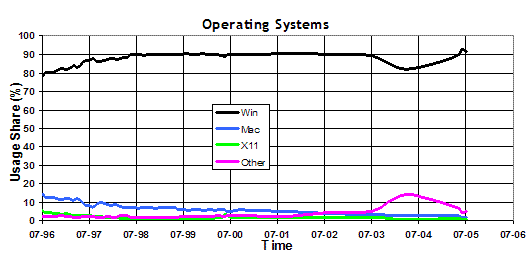
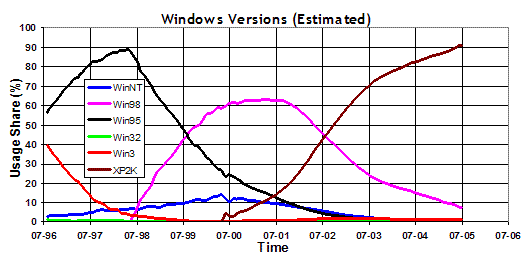
Stuart uses both Internet Explorer (IE) and a Firefox (Gecko) browser. In both cases he has the most recent version of the browser. (It is possible that his Gecko browser is a few months old.) He uses IE more often.
Notes for the team.
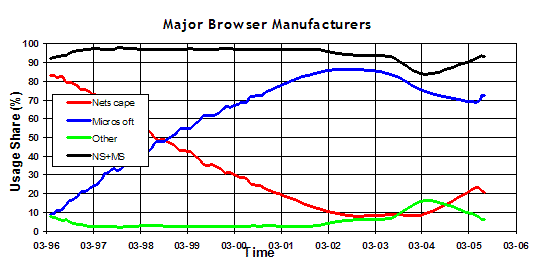
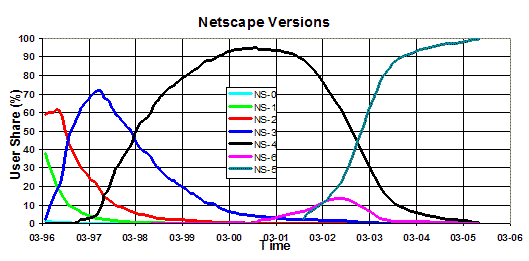
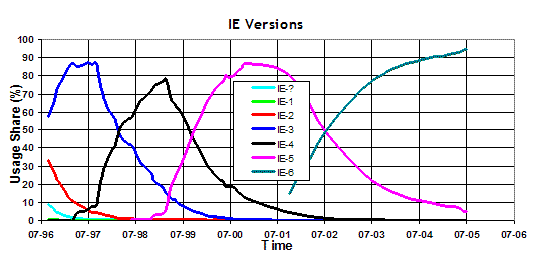
Stuart mostly uses a 1280x1024 screen size, sometimes 800x600.
Notes about screen characteristics.
Stuart has both JavaScript and Cookies switched on always. (He also has a cookie viewer and knows how to switch on JavaScript debugging, though he doesn't do these things very often.)
Some notes.
Stuart uses Windows XP and occasionally Windows 2003. When a new operating system is released he will generally use it within about 18 months. He mostly uses Internet Explorer. Sometimes he uses Firefox. For both browsers he quickly adopts the latest version (and patches).
He generally uses a screen resolution of 1280x1024, with an occasional use of 800x600. In both cases he uses a colour depth of 24 bits or greater. JavaScript is always turned on, as are cookies.
This profile is deliberately simple. Less browsers, less operating systems means less work. The fact that Stuart applies software updates quickly, helps save time and effort in the development team. The test panel should see the web site in one of the ways he does.
Even though the persona is simple it is based on real life data. This same data may give an indication of your Internet population, it may not. If you know your audience is specialised, like Firefox enthusiasts, or Mac using graphic artists your persona will be different from the Stuart described here.
Stuart is based on aggregating all visitors to a site. This won't be right in every case. If you have doubts, it's worth checking the profile of your real customers, and contrasting that with all site visitors. There could be a significant difference. You probably want your persona to reflect the customers more than it does the all comers profile. (While this is a real possibility, but I have not encountered it.)
The testing that derives from this persona is not the whole story. Irrespective of Stuart's persona, the web design is intended to work well for all users. There are techniques to ensure that. The persona defines the main thrust of development effort. The technical team will run deeper checks, even if the test panel does not.
In the past minor browser version changes have removed features. If you were dependent on such features you could be in trouble! While I see no need to run exhaustive checks for minor version changes, major versions deserve to be re-checked. Before the new browser version is heavily used there is an opportunity to make sure the site works well and adapt if needed. (Don't blame the web developers if the browser changes!!) Even if there is a major problem, there is time to react. For a time few people are using the browser, put another way Stuart only uses the new version for one visit in a hundred. If you react while usage is low little damage will be done.
My impression is that there is less good hard information about these details than there was six or seven years ago. Here are some sources that might be as useful to you, as they have been to me.